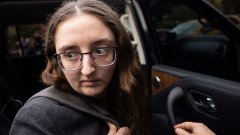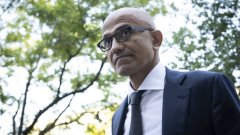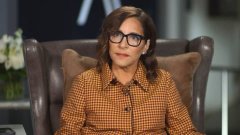
Caroline Ellison, who ran Sam Bankman-Fried's crypto hedge fund while also dating the FTX founder, told jurors in her second day of testimony that one way her boss was considering repaying FTX customer accounts was by raising money from Saudi Crown Prince Mohammed bin Salman.
She also highlighted Bankman-Fried's concerns with his public image, including his belief that his long, unkempt hair was "very valuable" in contributing to his narrative.
Ellison, 28, pleaded guilty in December to multiple counts of fraud as part of a plea deal with the government and is now viewed as the prosecution's star witness in Bankman-Fried's trial. In Tuesday, she said Bankman-Fried directed her and other staffers to defraud FTX customers by funneling billions of dollars to sister hedge fund Alameda Research.
Assistant U.S. attorney Danielle Sassoon wasted no time diving back into the questioning Wednesday when court was called to session.
After how FTX customer funds were used to repay Alameda loans, Ellison said Wednesday that crypto lender Genesis called back a bunch of loans in 2022 and asked to see a balance sheet. Because Alameda's actual balance sheet showed it had $15 billion in FTX customer funds, Bankman-Fried directed Ellison on June 28, 2022, to come up with "alternative" balance sheets that didn't look as bad, she said.
Ellison, wearing a buttoned gray blazer with her long hair swept over her left shoulder, said she discussed her concerns with Bankman-Fried as well as top execs Gary Wang and Nishad Singh. She said the group brainstormed ways to make the balance sheet look better.
After the meeting, Ellison prepared a number of different balance sheet variations to send to Genesis. Eventually, according to Ellison, Bankman-Fried chose the one that omitted a line saying "FTX borrows," hiding $10 billion in borrowed customer money. "Some was netted against related-party loans," she said, and "some netted against crypto."
That made it seem "like we had plenty of assets to cover our open term loans," Ellison said.
Ellison told jurors she "was in a constant state of dread" since she knew there were billions of dollars of loans being recalled that could only be repaid with money from FTX customers. She said she was "worried about the possibility of customer withdrawals" that could happen at any time.
"I was concerned that if anyone found out, it would all come crashing down," Ellison said. When asked by Sassoon why she continued with the scheme, Ellison said, "Sam told me to."
By October 2022, the internal balance sheet had liabilities of $15.6 billion, while the numbers they showed the lender indicated just under $8 billion. Ellison said Bankman-Fried was talking about trying to raise money from Mohammed bin Salman, also known as MBS, as a way to make FTX customers whole.
Ellison, a Stanford graduate and one of Bankman-Fried's earliest recruits to Alameda in 2017, was reportedly persuaded by Bankman-Fried to ditch her job at Wall Street trading firm Jane Street to join Alameda as a trader. At the time, the hedge fund was still in its original office in the San Francisco Bay area.
Six years later, Ellison is testifying against the 31-year-old Bankman-Fried, who faces seven , including wire fraud, securities fraud and money laundering, all tied to the collapse of FTX and Alameda late last year. If convicted in the trial, which began last week, Bankman-Fried could spend his life in prison. He has pleaded not guilty.
Ellison said Bankman-Fried directed FTX and Alameda employees to use the disappearing message setting on Signal and told them to be very careful about what they put in writing because of potential legal exposure. In addition to a companywide meeting about the Signal policy, Bankman-Fried also told employees that they should only write things on Slack that they're comfortable seeing on the front page of The New York Times.
Backing up to the summer and fall of 2022, Ellison provided more detail about her interactions with Bankman-Fried as his crypto firms' financial problems were becoming more apparent. Ellison said they talked about bringing in more money for FTX one of two ways: by acquiring BlockFi or by selling equity.
In August 2022, Ellison said, Bankman-Fried blamed her for Alameda's finances even though she'd been warning about FTX's expanding portfolio of venture investments and the need to repay FTX customer accounts. She said Bankman-Fried told her she should have hedged and, "speaking loudly and strongly," said it was her fault.
On the stand, Ellison took some blame, admitting she should have done things differently, "but Sam was the one who chose to make all the investments that put us in a leveraged position," she said.
Ellison, who'd started dating Bankman-Fried in the summer of 2021, said that by the fall of 2022 they'd been broken up for several months. She said she would try to avoid one-on-one contact with Bankman-Fried, though they were still talking on Signal and were together in group meetings. She said she still provided him the same regular updates on Alameda and its balance sheet.
Ellison said she kept a Google Doc that had a subcategory labeled "things Sam is freaking out about." It included "raising from MBS" (the Saudi crown prince), as well as "getting regulators to crack down on Binance," a rival exchange that was also an early investor in FTX. Bankman-Fried wanted to see Binance feel some pain because he saw that as the best way for FTX to increase market share, Ellison said.
Another worry on the list was "bad pr in the next six months," which Bankman-Fried feared would interfere with FTX's efforts to obtain a license for futures trading in the U.S., she said.
As testimony continued into Wednesday afternoon, Ellison was asked more about Bankman-Fried's concerns regarding bad public relations. She said he believed in a "very proactive" approach and spent a lot of time cultivating relationships with reporters. He invested in publications like Semafor and The Block, a crypto site, and he considered putting money into Vox and Forbes, she said.
Bankman-Fried tried to cultivate an image of himself as a smart, eccentric founder and said he wanted FTX to be perceived as a safe, reliable, audited and highly regulated exchange with the allure of it being offshore, Ellison said. He used Twitter as a "very important" source to help control the narrative around FTX, she added.
Bankman-Fried's personal look, particularly his hair, was also important to him. Ellison commented on how he dressed sloppily in 2022 and how he thought his hair was "very valuable" and key to the narrative. She said he swapped a nice company car for a Toyota Corolla because it was "better for his public image."
Ellison then went into her own emotional state. She said that when the business was imploding in November, she was on vacation in Japan. She said that in Signal messages with Bankman-Fried that week, she told him "this is the best mood I've been in in like a year."
Trying to fight back tears, Ellison said she went through a "lot of mood swings" and "felt a sense of relief" that she didn't have to "lie anymore."
After all the movement of FTX money, the company only had $4 billion to cover $12 billion in customer holdings, she said.
As the businesses were failing and withdrawal requests were rapidly mounting, Bankman-Fried wanted to reassure the public that Alameda's balance sheet wasn't a risk, Ellison said. Bankman-Fried had told Ellison and other Alameda execs to liquidate all of the firm's positions and send the money to FTX. That's when Ellison said she, following the lead of others, began to preserve her Signal messages.
Bankman-Fried said that in getting the message out, he couldn't be the one to post the tweet because he didn't want to be associated with Alameda. In a group thread, Bankman-Fried, Singh and former FTX executive Ryan Salame each sent their own versions of what they wanted Ellison to tweet. Ellison said she copied their suggestions, pasted them into a Google Doc and drafted a tweet in her own words.
"I was very upset and stressed out about it," she said.
During her late-day testimony, Ellison talked about her personal writings, some of which were recently . Ellison said that in Google Docs, she and Bankman-Fried shared thoughts on their relationship and their feelings. Ellison said she often wrote about being unhappy with their relationship and how it was impacted by issues at work.
"It made me feel bad," she wrote, "like an unequal partner in our relationship."
The leaks of Ellison's writings are part of what led to the in August, when a judge sent the FTX founder to a Brooklyn jail for alleged witness tampering.
Lastly, the government went over Ellison's cooperation agreement. She faces a maximum prison sentence of 110 years and will have to pay restitution to victims.
Now it's the defense's turn, as Bankman-Fried's attorney, Mark Cohen, begins cross-examination of Ellison. Shortly after Cohen got started, Judge Lewis Kaplan cut him off at 4 p.m. and said they would start fresh in the morning.
What followed was about 20 minutes of back and forth between prosecutors and the defense about what should be admissible in terms of an investment FTX made in artificial intelligence startup Anthropic. No decision was made by Kaplan on how to proceed.
WATCH: '



